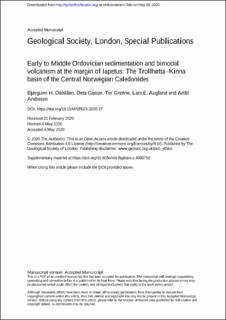| dc.contributor.author | Dalslåen, Bjørgunn Heggem | |
| dc.contributor.author | Gasser, Deta | |
| dc.contributor.author | Grenne, Tor | |
| dc.contributor.author | Augland, Lars Eivind | |
| dc.contributor.author | Andresen, Arild | |
| dc.coverage.spatial | Norway | en_US |
| dc.date.accessioned | 2021-02-15T14:06:06Z | |
| dc.date.available | 2021-02-15T14:06:06Z | |
| dc.date.created | 2020-11-01T09:24:31Z | |
| dc.date.issued | 2020 | |
| dc.identifier.citation | Dalslåen, B. H., Gasser, D., Grenne, T., Augland, L. E., & Andresen, A. (2020). Early–Middle Ordovician sedimentation and bimodal volcanism at the margin of Iapetus: the Trollhøtta–Kinna Basin of the central Norwegian Caledonides. Geological Society, London, Special Publications. | en_US |
| dc.identifier.issn | 0305-8719 | |
| dc.identifier.uri | https://hdl.handle.net/11250/2728167 | |
| dc.description | This is the accepted manuscript version (postprint) of an article published by Geological Society of London on 7 July 2020, available from https://doi.org/10.1144/SP503-2020-37 | en_US |
| dc.description.abstract | The late Neoproterozoic–Paleozoic Iapetus Ocean developed between Laurentia, Baltica, Siberia and Gondwana. Its Paleozoic closure history is recorded by volcano-sedimentary successions within the Caledonian orogen of Scandinavia, the British Isles and Newfoundland. We present new lithological, geochemical and geochronological data relevant for the Iapetan closure history from the hitherto poorly known Trollhøtta–Kinna Basin (central Norwegian Caledonides). This basin consists of alternating siliciclastic rocks, mid-ocean ridge basalts (MORBs), and felsic volcanic rocks highly enriched in, for example, Th, U and light REEs. Rhyolites from the stratigraphically upper part are dated by zircon U–Pb thermal ionization mass spectrometry to 473.3 ± 1.0 and 472.4 ± 0.7 Ma. Detrital zircon spectra indicate deposition after c. 480 Ma, with sediments derived from composite Cambro-Ordovician and Archean–Neoproterozoic landmass(es), possibly the Laurentian margin or a related microcontinent. The peculiar bimodal volcanic association is interpreted as an intermittent phase of marginal basin rifting, derived from a heterogeneous mantle source previously metasomatized by continental material. The tectonic mechanisms behind rifting could be slab retreat and/or break-off, or far-field tectonic forces within the Iapetan realm. Comparison of this basin with other Iapetus-related, similarly-aged volcano-sedimentary successions along the Caledonian–Appalachian orogen indicate that the bimodal MORBs and highly enriched rocks reflect a palaeotectonic setting hitherto unknown in the orogen. | en_US |
| dc.language.iso | eng | en_US |
| dc.publisher | Geological Society of London | en_US |
| dc.rights | Navngivelse 4.0 Internasjonal | * |
| dc.rights.uri | http://creativecommons.org/licenses/by/4.0/deed.no | * |
| dc.title | Early - Middle Ordovician sedimentation and bimodal volcanism at the margin of Iapetus: the Trollhøtta–Kinna Basin of the central Norwegian Caledonides | en_US |
| dc.type | Peer reviewed | en_US |
| dc.type | Journal article | en_US |
| dc.description.version | acceptedVersion | en_US |
| dc.rights.holder | © 2020 The Author(s) | en_US |
| dc.source.pagenumber | 27 | en_US |
| dc.source.volume | 503 | en_US |
| dc.source.journal | Geological Society Special Publication | en_US |
| dc.identifier.doi | 10.1144/SP503-2020-37 | |
| dc.identifier.cristin | 1843843 | |
| cristin.ispublished | true | |
| cristin.fulltext | postprint | |
| cristin.qualitycode | 1 | |

